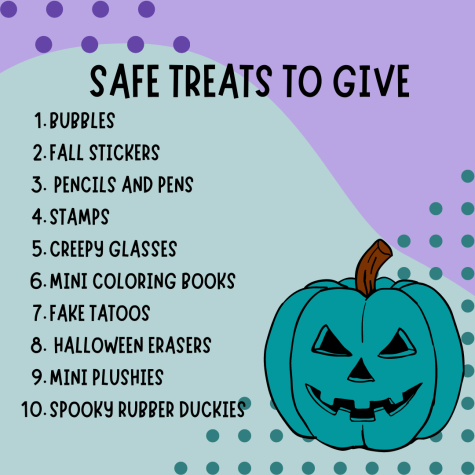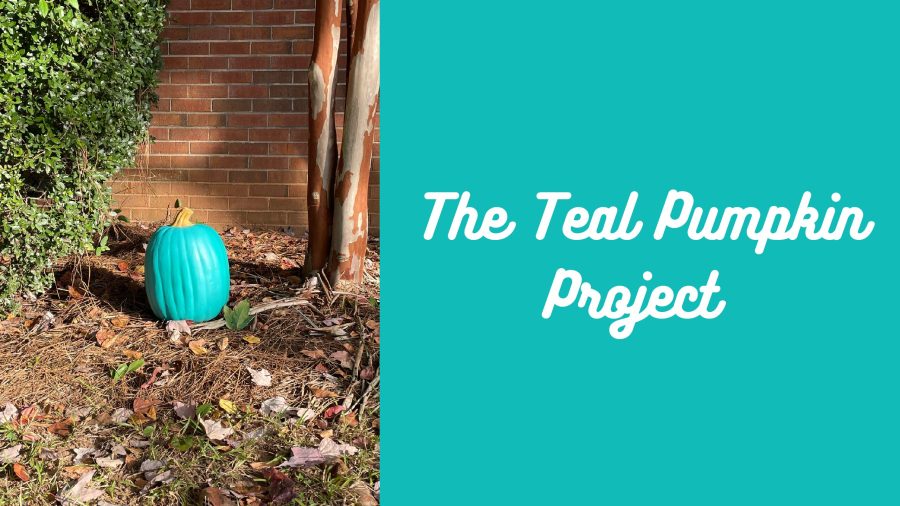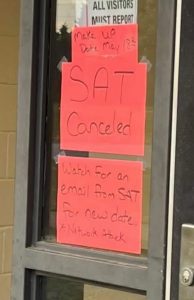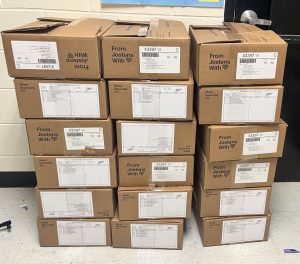As Halloween approaches, teal pumpkins raise awareness of food allergies
FARE’s Teal Pumpkin Project is trying to create awareness by having people put teal pumpkins outside their houses as an indicator for kids to know that their house has Halloween treats that are not food.
Oct 26, 2022
According to Food Allergy Research & Education (FARE), one in thirteen kids have food allergies, which can be a dilemma for parents and those children at special events like Halloween. Not even just Halloween, but also other holidays like Christmas or Valentine’s Day can make it hard for kids to feel included if they have food allergies and cannot eat all the candy and treats that their friends can.
FARE is a group whose mission is to enhance “the lives of individuals with food allergies empowering them to lead safe, productive lives with the respect of others through education and advocacy initiatives and improved awareness around healthcare options and treatment,” according to their website. FARE’s Teal Pumpkin Project is trying to create awareness by having people put teal pumpkins outside their houses as an indicator for kids to know that their house has Halloween treats that are not food. The project is a way for children to be safe and feel included in the fun involved in trick-or-treating.
Some stores like Target have already started selling large plastic pumpkins in the color teal and have signs explaining the concept. Stores have also started selling teal pumpkin candy buckets. This idea is for younger kids that may not know that they have a food allergy. Their parents can feel slightly easier with the idea that their child has an indicator that they have a food allergy and maybe they’ll get more candy or treats that they are more likely to be able to eat.
FARE has a map where people can add their houses so that people know where the safe trick-or-treating houses are located. Located on the same website as this map are a few safe trick-or-treating tips. Some of these include keeping food-free treats with you to trade with your child if they receive candy, having a no-eating while trick or treating rule so that there are no accidents, avoiding candy without ingredients, and checking labels for candy every time because the ingredients of a safe candy may have changed. A few other ideas are maybe having a Halloween party rather than trick or treating, or making safe goodie bags and giving them in advance to neighbors to give to your child.
The concept has students realizing the importance of an idea relating to inclusiveness with food allergies and even if it does not affect them personally they have started to think of their friends who might have food allergies.
“I’m not allergic to anything but my friends are, and they have a lot of allergies. It doesn’t really affect us when hanging out, we just avoid those allergies as a whole,” Sarah Arriola, a junior at MHS said.
“I don’t have any allergies so it’s hard for me to imagine what that’s like but I do have a friend who has lots of allergies. When we go out or eat anywhere but her house she often worries about what’s going in her mouth. She also sometimes doesn’t realize and almost puts things that could kill her in her mouth so I guess it’s important for me to watch what she eats as well,” Estrella Jones, a McIntosh junior said.
Some students who have food allergies understand how hard it is to go out and eat.
“I am someone with a food allergy. Whenever I go out with friends, especially to get food, I find it difficult. There have been cases where I’ve told my friends that I can’t go out to eat with them because I can’t eat at that restaurant. I always have to make sure that I tell the waiter about my allergy to make sure it is safe to eat the food, and while it shouldn’t feel embarrassing, it does. I have always packed my own lunch for school instead of buying one, and when I’m at friends’ houses and they offer me food, I usually decline. I don’t want to, but it’s safer than eating something that could hospitalize me,” Vetter said.
Once learning about the Teal Pumpkin Project, Vetter realized how much the concept would have impacted her as a child and reflected on what it was like trick-or-treating with her allergies.
“I think the Teal Pumpkin Project is genius. A few years back I ate a piece of candy out of my candy bag. I could tell it was a Hershey’s chocolate bar, but since it was dark I didn’t see the ‘with almonds’ also on the label. I ate it and I had an allergic reaction. If I had known about the teal pumpkin project, I could have avoided getting candy with nuts in it and avoided the whole allergic reaction entirely. I think I will get a teal pumpkin for my house this year, it’s a great idea and I would love to prevent kids from going through what I went through. I have a cousin with an allergy as well, so I will be on the lookout for teal pumpkins to let him know where he can safely trick or treat,” Vetter said.
Having learned more about the allergy initiative, some have concluded that they will pay closer attention to trick-or-treaters this Halloween night.
“I’d never heard of that Teal Pumpkin [Project] before but it’s good to know. I guess I’ll be on the lookout for them this Halloween,” Jones said.












